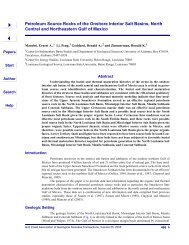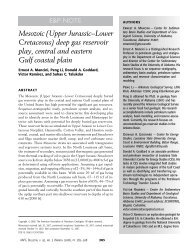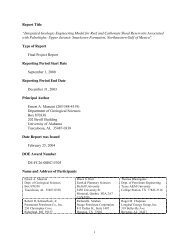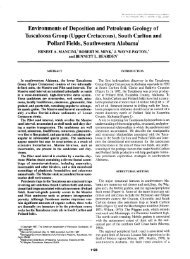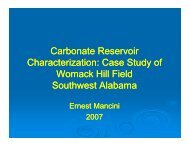Part 4 - Berg - Hughes Center
Part 4 - Berg - Hughes Center
Part 4 - Berg - Hughes Center
Create successful ePaper yourself
Turn your PDF publications into a flip-book with our unique Google optimized e-Paper software.
the high iron content seems to support the existence of the pre-Norphlet unconformity.<br />
From subsurface control, it appears as though the salt is laterally continuous and<br />
underlies parts of Texas, Arkansas, Alabama, and Mississippi, and nearly all of Louisiana<br />
(Andrews, 1960). A maximum thickness of 1,300 ft was recorded in the Placid No. 3<br />
Freeman-Smith (Sec. 14, T. 16 S., R. 13 W.), Calhoun County, Arkansas, and more than<br />
3,300 ft (still in salt at total depth of 14,890 ft) in the C.V.O.C. No. 2 Banks well (Sec.<br />
34, T. 21 N., R. 10 W.), Webster Parish, Louisiana. The thickness is believed to be<br />
associated with salt flowage, and may have been the result of basinward thickening of the<br />
salt. An original deposition of about 5,000 ft of bedded salt has been postulated but<br />
because of the topographically irregular floor of the basin, the thickness was not uniform<br />
(Parker and McDowell, 1955; Andrews, 1960). Bishop (1967) reported that precipitation<br />
of as much as 5,000 ft of Louann Salt was the result of concentrated marine waters<br />
flowing periodically into the basin, more or less isolated from the open sea by barrier<br />
bars. The CaCO3 and CaSO4 were precipitated, and the produced concentrated brines of<br />
NaCl were deposited in the basin.<br />
Upper Jurassic Louark (Norphlet, Smackover, Haynesville-Buckner)<br />
Norphlet Formation<br />
The Norphlet unconformably overlies the Louann Salt and older units near the<br />
margins of the basin where the Louann was not deposited or has been removed by<br />
erosion. Based on the relation of the Norphlet to the overlying Smackover, it has been<br />
assigned to the Upper Jurassic (Hazzard et al., 1947; Bishop, 1967). The Norphlet of<br />
Arkansas, Louisiana, and Texas attains a maximum thickness of about 150 ft and is<br />
composed primarily of red and gray shale and sandstone. The northernmost area of<br />
351




